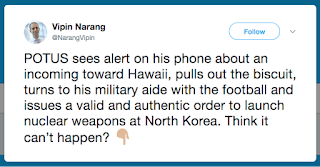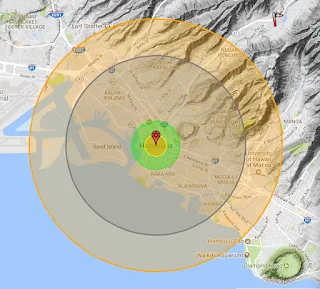A Hawaiian Missile Lullaby
"Q: What should one do to prepare for an incoming ICBM just minutes away?
A: Hug. Smile. Your short life was pretty good, wasn’t it? Reach for your ukelele."
A: Hug. Smile. Your short life was pretty good, wasn’t it? Reach for your ukelele."
This story has made the rounds and most people by now have caught it. A tech worker in the emergency management office in Honolulu screwed up and sent this alert out on Twitter:
Hawaii is 20 minutes as the missiles fly from North Korea, but it was not until 38 minutes had passed that the State government issued a retraction. US Congresswoman Tulsi Gabbard did not wait for that to tweet that it was a false alarm. In the meantime many people panicked, at least one fatal heart attack occurred, and children were being stuffed down storm drains.
Hawaii had already begun preparing for a nuclear attack before the President of the United States had taunted North Korea with that “my button is bigger than yours” tweet.
How anyone prepares for an incoming ICBM frankly baffles us.
In a bygone era the government would make civil defense films and slide shows and require them to be shown in schools. They installed large sirens and urged people to buy bomb shelters.
People were advised to stay in their shelters until the extent of the impact is known. Some people might in theory be told to stay inside for up to two weeks to avoid the radioactive fallout. What they would do after 2 weeks was left to science fiction writers.
In the wake of recent US-Korean belligerence, Hawaii had begun its new Civil Defense campaign for the 21st Century.
The campaign involves 30-second television advertisements, which will air on all local broadcast networks for six months, as well as educational brochures, which will be printed in six or seven languages and distributed to hotels for tourists. It will still take several months for the campaign to be rolled out, but the public service announcements are expected to start airing in September.
Hawaii schools will also begin practicing drills specifically for a missile attack — in addition to earthquake, fire, and active shooter training. The drills will be similar to an active shooter response, where schools go into lockdown and students shelter in place.
It is difficult to say whether this kind of campaign is designed to placate the calls for “something” to be done, to instill a sense of security, or to make people more afraid. Mostly, it accomplishes the last.
And yet, people are not yet afraid enough to act.
We are reminded of the false dogmas of the air campaign strategists in World War II who imagined, with no supporting evidence, that London could be bombed into submission, or Berlin, Köln and Dresden, or, for that matter all the major cities of Japan. With horrific civilian carnage, the bombmasters chased this illusion to the end of the war, only to discover from postmortem studies that bombing instills quite opposite emotions in the bombed populations — camaraderie, perseverance and nationalism. But this guilty knowledge did not keep the US from missile bombing civilians again in Korea, Vietnam, Iraq, Libya, Syria, and Yemen.
Whether you call it false dogma or fake news, there is a lot of disinformation flying around, some of it planted to gain advantage for less than noble causes. But then there is the South Korean Olympic Committee. They are very small in number and yet found a way to pull the US back from looking up launch codes.
 |
Vipin Narang is Associate Professor of political science at MIT,
focusing on nuclear proliferation and strategy |
Many more thoughtful people need to get strategic and innovative in
finding ways to quell tooth-and-claw battles between dinosaurs while
taking care not to be crushed underfoot. Like Umair Haque, we should all
be asking how far the decline of American Empire will go… transgression or annihilation?
M.I.T. Professor Emeritus Noam Chomsky, speaking last year in Cambridge, Massachusetts, was asked about the Korean situation by Democracy Now! news anchor Amy Goodman. Chomsky responded:
… the real question is: Is there a way of dealing with the problem? There are a lot of proposals. Sanctions. A big new missile defense system — which is a major threat to China and will increase tensions there. Military threats of various kinds. Sending an aircraft carrier, the [USS Carl] Vinson to North Korea…. Those are the kind of proposals as to how to solve it.
Actually there’s one proposal that’s ignored. It’s a pretty simple proposal. Remember: the goal is to get North Korea to freeze its weapons and missiles systems.
So, one proposal is to accept their offer to do that. It sounds simple. They have made a proposal — China and North Korea — have proposed to freeze the North Korean missile and nuclear weapons systems and the US instantly rejected it. And you can’t blame that on Trump. Obama did the same thing. A couple of years ago the same offer was presented, I think it was 2015, the Obama administration instantly rejected it.
And the reason is that it calls for a quid pro quo. It says in return the US should put an end to threatening military maneuvers on North Korea’s borders, which happen to include, under Trump, sending of nuclear-capable B52s [and B1 and B2 bombers] flying right near the border.
Maybe Americans don’t remember very well, but North Koreans have a memory of, not too long ago, when North Korea was absolutely flattened, literally, by American bombing. There were literally no targets left.
I really urge people who haven’t done it to read the official American military histories, the Air Quarterly Review, the military histories describing this. They describe it very vividly and accurately. They say there just weren’t any targets left. So what could we do? Well, we decided to attack the dams, the huge dams — a major war crime. People were hanged for it at Nuremberg, but put that aside. And then comes an ecstatic, gleeful description of the bombing of the dams and the huge flow of water which was wiping out valleys and destroying the rice crop, “upon which Asians depend for survival” — lots of racist comments — but all with exaltation and glee. You really have to read it to appreciate it. The North Koreans don’t have to bother reading it. They lived it.
So when nuclear-capable B52s [etc.] are flying on their border, along with other threatening military maneuvers, they’re kind of upset about it. Strange people. And they continue to develop what they see as a potential deterrent that might protect the regime, and the country in fact, from destruction. …
Honolulu Magazine ran what it called “worse case scenarios,” of what would happen if North Korea sent a missile to Hawaii. Oddly, the magazine’s editors kept to a small blast radius by calculating for a 200-pound warhead with a yield of 10 kt TNT, a third to half less powerful than the bombs dropped on Hiroshima and Nagasaki, 54 years before.
One is left wondering why anyone would downplay the power of modern atomic arsenals in this way. What possible good would it do? Would it reassure people with expensive homes in the outlying suburbs? Would it suggest that perhaps fallout shelters might actually work? Would it give someone the idea to stuff their kids down a storm drain in the event of a tweeted warning?
Ten kilotons is child‘s play. North Korea tested a 150 kt device last year — 15 times larger. The blast pattern would look like this:
 |
| Inner to outer: fireball, lethal x-ray radius, blast radius, 3d degree burn radius |
Within the yellow area anyone hiding in a storm drain would be instantly vaporized. Between the airport and Waikiki Beach roughly 80 percent would be killed by blast pressure or burns.
Q: What should one do to prepare for an incoming ICBM just minutes away?
A: Hug. Smile. Your short life was pretty good, wasn’t it? Reach for your ukelele.
A: Hug. Smile. Your short life was pretty good, wasn’t it? Reach for your ukelele.
The average warhead in the US arsenal has a 100kt yield and weighs 2 tons. A couple dozen of those little puppies might be packed into a single MIRV “delivery vehicle.” A more typical choice for a city killer ICBM would be a Minuteman III missile dropping a W-78 warhead with a yield of 350 kt.
Assuming such a weapon were to be centered on Honolulu, the blast radius would extend past Diamond Head. Effects radii for 350 kiloton airburst (smallest to largest):
Fireball radius: 0.63 km (1.27 km²)
Maximum size of the nuclear fireball; relevance to lived effects depends on height of detonation. If it touches the ground, the amount of radioactive fallout is significantly increased. Minimum burst height for negligible fallout: 0.57 km.
Air blast radius (5 psi): 4.95 km (77.1 km²)
At 5 psi overpressure, most residential buildings collapse, injuries are universal, fatalities are widespread. Optimal height of burst to maximize this effect is 2.2 km.
Thermal radiation radius (3rd degree burns): 7.67 km (185 km²)
Third degree burns extend throughout the layers of skin, and are often painless because they destroy the pain nerves. They can cause severe scarring or disablement, and can require amputation. 100% probability for 3rd degree burns at this yield is 10.7 cal/cm2.
For more information about the model, click here.

Okay, so the supreme GOP leader’s nukes really are larger. But wait, North Korea’s ICBMs can’t just hit Hawaii, they can reach the entire continental United States from Key West to Bangor.
Suppose instead of an incoming missile, an adversary, be it North Korea, a Colombian drug cartel, or a crazed BitCoin Billionaire were to pack plutonium into a drone midget submarine. Weight is no limit, so they could wrap a Tsar Bomba (the largest hydrogen bomb ever tested) in its U-238 iron-man suit to give it the maximum 100 Mt punch. In Honolulu, the 3d degree burn radius would extend 74 km, to Molokai. 984,000 people would be in the blast radius. Never mind the radiation effects.
Of course, if you have a drone midget submarine why limit your target to Hawaii? Any coastal city would do. If you sailed up San Francisco Bay you could reach 8.9 million people, not including fallout.
Yes, surely those duck and cover drills will be helpful then.
It seems to us what might be more helpful would be for the United States to once more participate in the UN disarmament talks and return to the path of dismantling and banning all nuclear weapons, forever. After all, you never know who might be elected President some day.








Comments
There are ways to optimize one's chances of survival when facing all kinds of earthly physical danger. No one ridicules civil defense for hurricanes, fires, floods or earthquake. Why ridicule defending oneself from nuclear attack (or even climate change)?